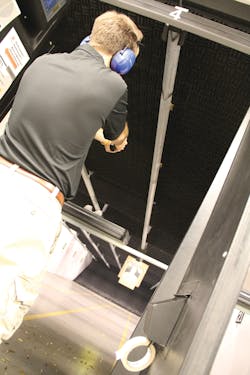It’s not hard to convince many Wisconsinites to voyage south during the Midwest winter months. Add in the opportunity to get the full insight on a firearms training company with more than 80 years experience in the industry and a foot in multiple aspects of the firearms training quotient and you’ve got LET on a plane earlier this year to visit Meggitt Training Systems at its Suwanee, Ga.-based facility with some 235,000 square feet of space to exercise its training arm.
Meggitt Training Systems combines simulation firearms training and live-fire systems to offer solutions for the military, law enforcement and commercial firearms training and practice needs. The company boasts 10,000 live-fire ranges and 5,200 virtual systems in place internationally. Used by the Marine Corps. and the Ministry of Defense in England, Meggitt is also the company that owns the Firearms Training Simulator (FATS) system as well as a multitude of well and lesser-known training products. From marksmanship and shooting judgment instruction tools to specialty live-fire training house, Meggitt offers a variety of options to help agencies keep their team trained in the latest law enforcement firearms tactics. To keep up with today’s technology, Meggitt has put forth several new training-related products for firearms skills teaching and improvement. Its wireless target retrieval system for indoor and outdoor ranges, the FATS L7 system, advanced immersion technology and a mobile sim system are among the latest offerings from the training system supplier.
Indoor range system
Creating an indoor range system brings with it multiple challenges, including need for ventilation, possibly lead abatement, general environmental concerns, zoning regulations and finding the proper range equipment. Meggitt’s answer to these challenges are a variety of indoor range products such as its target carrier and retrieval system, a range control device, steel and rubber bullet traps and shooting stalls. Released from the company last year is the Meggitt Training System Next Generation Wireless Target (XWT) retrieval system, a wireless, 360-degree turning target retrieval system with a modern touchscreen interface. Another version of the XWT was released at SHOT Show in Las Vegas in January for outdoor range use. Meggitt says its XWT eliminates the range’s requirement to replace frayed cables and continually adjust the tension of cables found on traditional target retrievers. The XWT system is operated via wireless communication through a touchscreen controller. As the company’s vice president of law enforcement sales, David O’Meara, notes, wireless is an industry standard for most everything and targetry should be no different. O’Meara has been with the company through its various transitions and acquisitions of the last 20 years, working in all aspects of the business from sales to installation and range design. Recently, Meggitt helped a local commercial shooting range solve several range development issues that will celebrate a year in business this month, offering 12 rifle-rated lanes and Meggitt’s XWT.
Marksmanship & judgmental training
Many officers are already familiar with a Meggitt staple: the FATS (firearms training simulator) system, which was acquired by the company in 2006 but has long been in use across the nation for marksmanship as well as instructor-lead shoot or don’t-shoot decision-making scenarios. The latest version of the FATS system is the L7, a compact firearms training simulator. FATS L7 includes both marksmanship training and video training modes; marksmanship training ranges from basic to advanced, and judgmental training helps instructors develop shoot or don’t shoot skills and response from trainees, allowing for escalation or de-escalation of a situation based on the trainee’s actions.
At Meggitt’s facility in Georgia, a training theater is set up to show the FATS system’s team-training capability. Using its tethered weapon simulators and BlueFire wireless weapons (through Bluetooth technology), Meggitt simulation training can support up to eight system-controlled weapons simultaneously during judgmental video training, giving the team the simulated option to approach a target practice or judgment-based scenario together, plus incorporating a variety of firearm types (options include Sig P226, Beretta M9, Walther P99, M4 and M16-type simulators).
Meggitt’s library of video courseware exceeds 200 scenarios allows officers to analyze a situation and potential threat, and respond accordingly. Verbal commands, less-lethal engagement using optional chemical spray devices, Taser simulators and lethal force with firearms supports training scenarios for newbie recruits to seasoned officer refreshers in controlled environments for critiquing. “We cater for the rookie in the academy to the experienced, scenario-based training to the most advanced officers,” O’Meara says. “Our training caters to that breadth and is ever-evolving thanks to our engineering department.” As O’Meara describes it, his background is in helping “with officers on the ground and taking their needs and requests seriously, because they know what they’re doing.”
Meggitt also offers a Hostile Fire Simulator that returns fire on trainees using FATS to make use of force and judgmental training and put trainees under fire, increasing their stress level. In fact, Meggitt has invested seriously in the study of human factor elements, devoting a research branch headed by law enforcement retiree Randall Murphy.
Human factors research
Meggitt takes on the 4D theater sim approach with its Advanced Immersion Technology branch, which joins human factors and performance research with the marksmanship and judgmental training-type scenario. Murphy joined Meggitt in 2007 to help the company design and research a program examining fight-or-flight in law enforcement and the military. “We found that you can activate the sympathetic nervous system in virtual situations and developed the method of how to do [so],” Murphy, who worked with the Kansas City, Kan., PD for 30 years, says. In essence, Meggitt’s advanced immersion technology can “give the officer and the soldier the added benefit of having been” to a battlefield or tactical entry situation, for example, Murphy explains.
The demonstration of the advanced immersion tech showed how the company is examining aspects of how people respond in combat, including law enforcement, and puts the trainee in a simulated environment meant to make the user feel submerged in an actual event rather than a trainee watching a screen. Murphy illustrates how the “immersion” experience works, with a set up that includes a four-walled room with a wall-sized screen playing a scene in point-of-view style. The training-weapon-armed learner interacts with the elements in the video scenario, which includes 4D interactivity like debris coming at the learner as a result of a bomb blast in the scenario. This puts the trainee under stress, which, like many of the Meggitt Training Systems’ products, is done “so you can predict who’s going to react well under serious stress and who’s not,” as well as address or correct the tactics, O’Meara says. “Randall has brought an incredible amount of information to the table to help us design our systems [which] is really, really important going forward for the company.”
‘From rookie to ready’
A maxim from Meggitt’s company materials says its systems aim to take “you from rookie to ready” with a variety of solutions to do so, backed and based on its decades of experience in the firearms training industry. With products in virtual simulations, live fire practice and original human factors research and development, Meggitt aims to give its users the modern tools to shoot with skill. ¦

Tabatha Wethal | Editor
Award-winning writer Tabatha Wethal is a previous editor leading Law Enforcement Technology magazine and assisted with other publications. She was with the magazines since 2007.



